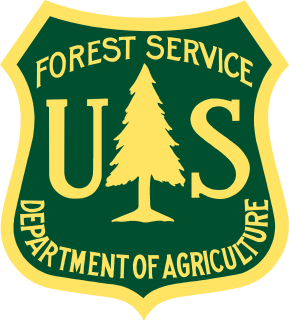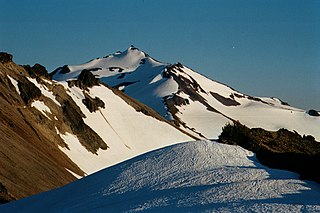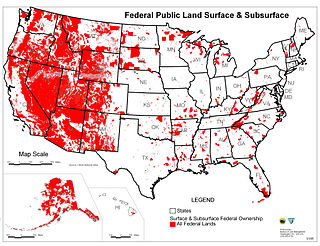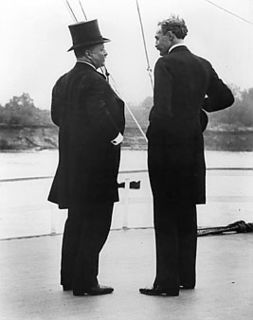Related Research Articles

The United States Forest Service (USFS) is an agency of the U.S. Department of Agriculture that administers the nation's 154 national forests and 20 national grasslands. The Forest Service manages 193 million acres (780,000 km2) of land. Major divisions of the agency include the Chief's Office, National Forest System, State and Private Forestry, Business Operations, and Research and Development. The agency manages about 25% of federal lands and is the only major national land management agency not part of the U.S. Department of the Interior, which manages the National Park Service, the U.S. Fish and Wildlife Service, and the Bureau of Land Management.

In the United States, national forest is a classification of protected and managed federal lands. National forests are largely forest and woodland areas owned collectively by the American people through the federal government, and managed by the United States Forest Service, a division of the United States Department of Agriculture. The U.S. Forest Service is also a forestry research organization who provides financial assistance to state and local forestry industry. As of 2020, there are 154 national forests in the United States.

Gifford Pinchot was an American forester and politician. He served as the fourth chief of the U.S. Division of Forestry, as the first head of the United States Forest Service, and as the 28th governor of Pennsylvania. He was a member of the Republican Party for most of his life, though he joined the Progressive Party for a brief period.

Gifford Pinchot National Forest is a National Forest located in southern Washington, managed by the United States Forest Service. With an area of 1.32 million acres (5300 km2), it extends 116 km along the western slopes of Cascade Range from Mount Rainier National Park to the Columbia River. The forest straddles the crest of the South Cascades of Washington State, spread out over broad, old growth forests, high mountain meadows, several glaciers, and numerous volcanic peaks. The forest's highest point is at 12,276 ft. at the top of Mount Adams, the second tallest volcano in the state after Rainier. Often found abbreviated GPNF on maps and in texts, it includes the 110,000-acre (450 km2) Mount St. Helens National Volcanic Monument, established by Congress in 1982.

Federal lands are lands in the United States owned by the federal government. Pursuant to the Property Clause of the United States Constitution, Congress has the power to retain, buy, sell, and regulate federal lands, such as by limiting cattle grazing on them. These powers have been recognized in a long line of United States Supreme Court decisions.

Lassen National Forest is a United States national forest of 1,700 square miles (4,300 km2) in northeastern California. It is named after pioneer Peter Lassen, who mined, ranched and promoted the area to emigrant parties in the 1850s.

Pisgah National Forest is a National Forest in the Appalachian Mountains of western North Carolina. It is administered by the United States Forest Service, part of the United States Department of Agriculture. The Pisgah National Forest is completely contained within the state of North Carolina. The forest is managed together with the other three North Carolina National Forests from common headquarters in Asheville, North Carolina. There are local ranger district offices located in Pisgah Forest, Mars Hill, and Nebo.

The Transfer Act of 1905 transferred the forest reserves of the United States from the Department of the Interior, General Land Office to the Department of Agriculture, Bureau of Forestry.
The Clarke–McNary Act of 1924 was one of several pieces of United States federal legislation and was named for Representative John D. Clarke and Senator Charles McNary.

The General Revision Act of 1891, also known as the Forest Reserve Act of 1891, was a federal legislation signed in 1891 by President Benjamin Harrison. The General Revision Act of 1891 reversed previous policy initiatives, such as the Timber Culture Act of 1873, in which land fraud was readily achievable by wealthy individuals and corporations. The acquisition of vast mineral and timber resources in the Western United States was often cited as a governing motive for such individuals and corporations to claim land rights for future settlement and resource depletion activities. The legacy of the General Revision Act of 1891 is frequently credited as its serving as a catalyst to a series of federal land reform initiatives, notably under President Theodore Roosevelt. From the Reclamation Act of 1902 to the formation of the United States Forest Service in 1905, the General Revision Act of 1891 acted as a critical first piece of federal legislation granting increased plots of publicly allotted land and decreased extraction rights to privately held western land owners in the early 20th century.

The National Wildlife Refuge System in the United States has a long and distinguished history.
Federal Indian policy establishes the relationship between the United States Government and the Indian Tribes within its borders. The Constitution gives the federal government primary responsibility for dealing with tribes. Some scholars divide the federal policy toward Indians in six phases: coexistence (1789–1828), removal and reservations (1829–1886), assimilation (1887–1932), reorganization (1932–1945), termination (1946–1960), and self-determination (1961–1985).
Federal Power Commission v. Tuscarora Indian Nation, 362 U.S. 99 (1960), was a case decided by the United States Supreme Court which determined that the Federal Power Commission was authorized to take lands owned by the Tuscarora Indian tribe by eminent domain under the Federal Power Act for a hydroelectric power project, upon payment of just compensation.
Midnight forests was a nickname given to the forests created by President of the United States Theodore Roosevelt near the end of his term as president.
The Forest Service Organic Administration Act of 1897 provided the main statutory basis for the management of forest reserves in the United States, hence the commonly used term "Organic Act". The legislation's formal title is the Sundry Civil Appropriations Act of 1897, which was signed into law on June 4, 1897, by President William McKinley.

Starting in 1876, and undergoing a series of name changes, the U.S. Forest Service grew to protect and use millions of acres of forest on public land. Gifford Pinchot, an early advocate of scientific forestry, along with President Theodore Roosevelt and conservation organizations, led the effort to manage forest for the public good.

Conservation in the United States can be traced back to the 19th century with the formation of the first National Park. Conservation generally refers to the act of consciously and efficiently using land and/or its natural resources. This can be in the form of setting aside tracts of land for protection from hunting or urban development, or it can take the form of using less resources such as metal, water, or coal. Usually, this process of conservation occurs through or after legislation on local or national levels is passed.

The New Jersey Forest Fire Service (NJFFS) is an agency within the New Jersey Department of Environmental Protection. Founded in 1906 with a focus on wildland fire suppression and fire protection, the Forest Fire Service is the largest firefighting department within the state of New Jersey in the United States with 85 full-time professional firefighting personnel, and approximately 2,000 trained part-time on-call wildland firefighters throughout the state. Its mission is to protect "life and property, as well as the state's natural resources, from wildfire".

Frederick Erskine Olmsted, also known as Fritz Olmsted, was an American forester and one of "the founders of American forestry". He is credited with helping to establish the National Forest system in the United States and developed the system of forest management that was applied nationally. He also was a consulting forester and taught at Harvard University. With Olmsted, "Forestry was not merely a career or a business profession; it filled his whole soul and he knew how to love forestry, fight for forestry, and suffer for forestry."
References
- ↑ Davis, Richard C. "Weeks Act 1911." Encyclopedia of American Forest History(1983): 685.
- ↑ A History of Water Resource activities of the United States Department of Agriculture
- ↑ Cermak, Robert W. Fire In The Forest-A History of Forest Fire Control on the National Forests in California 1898-1956 USDA Forest Service Publishers, 2005 p.58 ISBN 1-59351-429-8
- ↑ Protection and Restoration
- ↑ National Forest Reservation Commission Members, 1911-1966
- ↑ Weeks Act - Forest History Society, Retrieved 2015-11-23.

